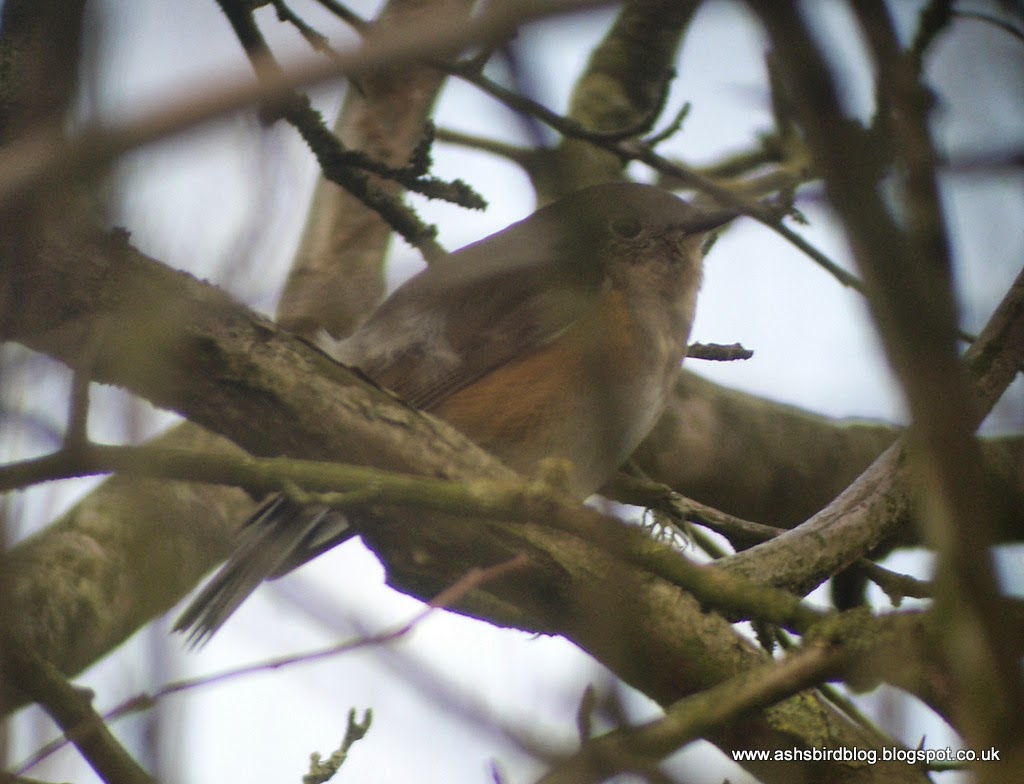I arrived at Snodland and after parking up near the Tesco distribution depot I made my way towards the Sandhole Golf Club. I had seen that the bird was being spotted near a large pile of sand near the Golf course so wandered across the footpath that ran alongside it. I ambled along checking every viable spot visible from the path with no luck, a calling Green Woodpecker then came in to view as it flew overhead but I could see little else.
As I followed the path towards the golf course I met a incredibly nice birder who I chatted with and he very kindly took me to the location behind Sandhole farm where the Hoopoe had been seen on most occasions.
We arrived to find a dozen or so people viewing the field from two locations along the hedgerow, sadly they hadn't seen anything and a few of them decided to take a walk around a route that led back round the golf course, and behind some of the gardens and fields that the Hoopoe had been seen around. I stayed and looked carefully through every blade of grass and tree branch just in case it was hiding away.
Ten minutes must have passed and I was just about to have a wander to see if I could find it anywhere else, then one of the birders that had left earlier to take a look around returned. He calmly asked if we'd seen it, to which everybody replied that they hadn't, he then told us that it was sat under a trampoline, in a back garden just up the path. Everybody soon mobilized and trooped up the footpath and within a minute we were looking at the Hoopoe which was sat under a trampoline and just visible. It hopped around under the trampoline for a couple of minutes, amongst some large muddy furrows in the back garden's lawn, then suddenly it raised it's crest fully then took flight.
I was very pleased to have seen it but really wanted to get some better views so decide to stay and see if I could find it amongst the numerous perfect habitats for it that surrounded the golf course and gardens. A couple of birders had met the owners of the garden we had all seen it in and they very kindly gave permission to allow somebody to go in to the garden and have a very quick look to see if it was still there, they did and it wasn't there.
I spent the rest of the afternoon looking for it in various locations with no luck. A very vocal Chiffchaff distracted my attention for awhile and I watched it singing away above me at the top of tree, amongst a small overgrown orchard a Blackcap began to sing from a hedgerow within a few feet from me, it's fluty call advertising it's presence but never showing itself until it finally flew from the hedgerow and across the orchard. It perched in view then dropped down in to a nearby thicket from where it began to sing again.
I headed back out in to the golf course after deciding to take one final look at all the Hoopoe's favoured haunts before I left, just in case. The golf course had a small number of Wood Pigeons feeding on it, a few Blackbirds, Mistle and Song Thrushes and a pair of Green Woodpeckers, above the Golf club car park circled a Sparrowhawk.
Disappointingly the Hoopoe didn't reappear and I left feeling rather lucky that I had seen it even if it wasn't the best of views.
Saturday 26 April 2014
Tuesday 15 April 2014
Gone But Never Forgotten
When you walk through a storm, hold your head up high
And don’t be afraid of the dark
At the end of the storm, there’s a golden sky
And the sweet, silver song of a lark
And don’t be afraid of the dark
At the end of the storm, there’s a golden sky
And the sweet, silver song of a lark
Walk on through the wind
Walk on through the rain
Though your dreams be tossed and blown
Walk on through the rain
Though your dreams be tossed and blown
Walk on, walk on
With hope in your heart
And you’ll never walk alone
You’ll never walk alone
With hope in your heart
And you’ll never walk alone
You’ll never walk alone
Walk on, walk on
With hope in your heart
With hope in your heart
And you’ll never walk alone
You’ll never walk alone
You’ll never walk alone
Saturday 12 April 2014
Monday 7 April 2014
Tuesday 1 April 2014
Grey Phalarope (Phalaropus fulicarius) - Hove Lagoon, East Sussex. January 2014
The Phalarope species have always been a favourite of mine and I've been lucky to see all three species in the UK, Grey, Red-necked and the rare Wilson's Phalarope. The Grey Phalarope is no bigger than a Starling and breeds on coastal tundra in the high Arctic and spends the winter at sea off the west coast of Africa, which for its small dainty size is surprising to say the least. All three species of Phalarope are sexually dimorphic, meaning that the female of the species has brighter breeding plumage and initiates breeding, it is the males that are left to tend to the eggs and bring up the young.
It is an uncommon annual migrant to the UK, with numbers depending very much on the weather conditions. Most frequently it is seen off south-west coasts during migration, especially after strong storms and usually in late autumn. Some birds get driven inland during bad weather and some have been known to winter.
When news of a Grey Phalarope which had been found in a paddling pool at Hove Lagoon, East Sussex filtered out across the birding community I instantly became interested. Various photos showed this bird to be within incredibly close proximity to it's observers and that just added to my interest, I decided that once there was a break in the dreadful weather that had engulfed the UK for sometime and if the bird was still present I would head down and see it.
After a few minutes walk we arrived at the paddling pool next to the Big Beach Café. I was taken back by how small the pool was, it wasn't particularly wide and it certainly wasn't deep which was proven when a gentlemen walked out to the middle of the pool to distribute a handful of worms with the water barely reaching the top of his walking boots. The biggest surprise was how close the Grey Phalarope actually was, as I stood on the outside of the paddling pool looking over the adjacent fence it was an incredible sight to see this dainty wader swimming around a few feet in front the assembled crowd
I had close views of a Grey Phalarope at Farmoor Reservoir, Oxon a some years ago but this was so much closer, it was so close at times you could have put your hand out and patted it on the head. The supply of worms it was getting for free obviously helped but it seemed happy to go about it's business as usual and wasn't under any stress from the attention it was receiving. I believe the assumption is that this Phalarope had probably never had human contact before and therefore had no reason to fear close contact. It seemed a pretty plausible especially when the Phalarope came within a few feet without a care in the world.
Every now and again it wandered out of the water to preen, stretch it's wings and have a wander around the edge of the pool. On one such occasion I was delighted to have the Phalarope right in front of me as it did just this, I was even more pleased when I realised that I had managed to capture this on my camera.
The Phalarope was certainly making the most of the food that was being offered, swimming quickly around the pool then suddenly turning and spinning round and round like a spinning top to stir up invertebrates in the water below, it then suddenly stops and begins to stare down to the waters surface. Then the Phalarope upends, immersing it's head beneath the waters surface whilst showing it's white underbelly and partially webbed feet. In a matter of moments the Phalarope returns to the surface splashing drops of water across it's head and body, which in turn roll down it's waterproof feathers back in to the water. In it's beak is a small blood worm which is swallowed down quickly before it returns to swimming and spinning around the paddling pool again.
It was quite surreal setting with the bustling seafront on one side and adjacent play park that was in constant use on the other, In between these sat the paddling pool with the Grey Phalarope and it's many observers in situ. On the outside of the paddling pool perimeter fence a crowd of enthralled passers-by stopped to enquire about the seafront's star attraction with many taking photos on their cameras and phones.
As the sun started to fade the temperature started to drop and after being in the company of this amazing little Phalarope for a good few hours my fingers started to numb with the cold. I started to pack up my gear with one eye on a number of large Gulls and Crows that were now perusing the adjacent play park, paddling pool and probably the Phalarope itself.
A fantastic bird, on a beautiful winters day, who could ask for more.
Subscribe to:
Posts (Atom)













































































